A Garden from Scratch: 7 Ways to Save Money When Creating a Garden
Introduction
Creating a garden from scratch can be a rewarding experience, but it can also be costly. From purchasing plants and seeds to investing in tools and materials, the expenses can quickly add up. However, with a little creativity and resourcefulness, there are several ways to save money while still creating a beautiful and thriving garden. In this article, we will explore seven budget-friendly tips to help you save money when starting a garden.
1. Start with a Plan
Before you start buying plants and materials, take the time to create a detailed plan for your garden. Consider factors such as the size and layout of your garden, the types of plants you want to grow, and any specific features you’d like to include. By having a clear plan in place, you can avoid impulse purchases and ensure that you’re only buying what you need.
2. Use Seeds Instead of Plants
One of the easiest ways to save money when creating a garden is to start plants from seeds instead of purchasing fully-grown plants. Seeds are often much cheaper than plants, and they allow you to grow a wider variety of plants at a fraction of the cost. Plus, planting seeds can be a fun and rewarding experience that allows you to witness the entire growth process.
3. Buy in Bulk
When purchasing plants, seeds, or materials for your garden, consider buying in bulk to save money. Many garden centers offer discounts for buying larger quantities, so you can stock up on the essentials while keeping costs low. Additionally, buying in bulk can help you save on shipping fees and reduce the amount of packaging waste.
4. Repurpose Materials
Instead of buying new materials for your garden, look for ways to repurpose items you already have or find inexpensive alternatives. For example, old buckets or containers can be used as planters, and branches or twigs can be crafted into garden stakes. By thinking creatively and using what you have on hand, you can save money while adding a unique touch to your garden.
5. Grow Perennials
Perennials are plants that come back year after year, making them a cost-effective choice for your garden. Unlike annuals, which need to be replanted each year, perennials require less maintenance and can save you money in the long run. Additionally, many perennials can be divided and shared with friends, allowing you to expand your garden without spending extra money.
6. Practice Smart Watering
Watering your garden can quickly drive up your water bill, so it’s important to practice smart watering techniques to save money. Consider investing in a rain barrel to collect rainwater for your garden, or install a drip irrigation system to water plants efficiently. By conserving water and using it wisely, you can save money while keeping your garden healthy and thriving.
7. Join a Garden Swap or Exchange
One of the best ways to save money on plants and materials for your garden is to join a garden swap or exchange group. These groups allow members to trade plants, seeds, tools, and other garden supplies with each other, often for free. Not only can you save money by participating in a garden swap, but you can also meet other gardeners in your community and learn new tips and techniques for your garden.
Conclusion
Creating a garden from scratch doesn’t have to break the bank. By following these seven budget-friendly tips, you can save money while still creating a beautiful and thriving garden. From starting with a plan to joining a garden swap, there are plenty of ways to cut costs and stretch your gardening budget. With a little planning and creativity, you can create a garden that is both affordable and sustainable.
FAQs
1. What are some other ways to save money when creating a garden?
In addition to the tips mentioned in this article, you can save money by sourcing plants from local nurseries or plant sales, using homemade compost and mulch instead of store-bought products, and investing in quality tools that will last for years to come.
2. How can I make my garden more environmentally friendly?
To make your garden more environmentally friendly, consider using organic gardening practices, planting native species that require less water and maintenance, and avoiding chemical pesticides and fertilizers. You can also create habitats for beneficial insects and wildlife to promote biodiversity in your garden.
3. What are some beginner-friendly plants to grow in a garden?
Some beginner-friendly plants to consider growing in your garden include tomatoes, herbs like basil and mint, zinnias, sunflowers, and succulents. These plants are relatively easy to care for and can provide a bountiful harvest or colorful blooms with minimal effort.




